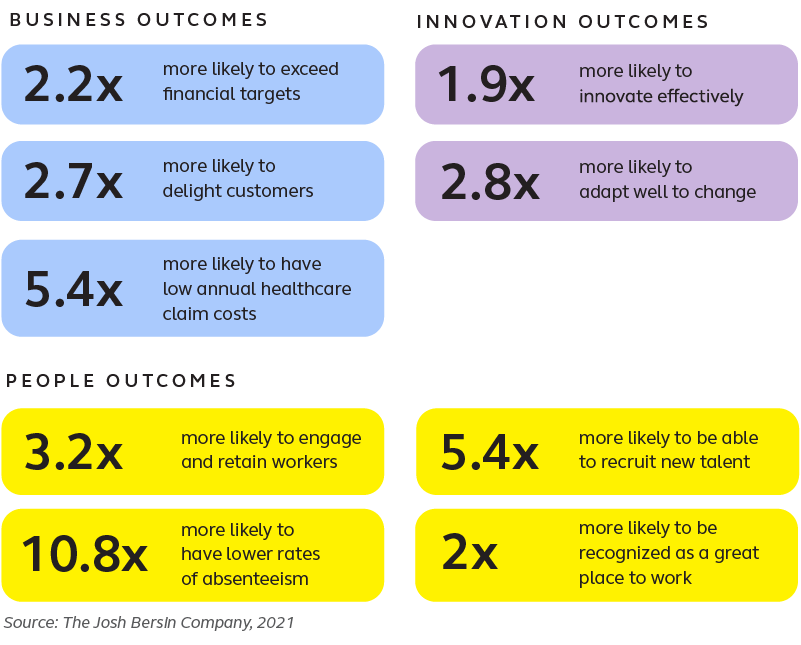In recent years, a convergence of factors has created an uncomfortable new reality for employees and employers alike. Unrelenting uncertainty, a global pandemic/endemic, war, inflation and a potential recession have shaken our very foundation. Employees are stressed and overwhelmed, leading to an increase in mental health challenges, financial concerns and trepidation over healthcare decisions impacting their ability to bring their best selves to work and live their best lives at home. Meanwhile, employers are trying to keep spending in check while still recruiting and retaining the workers they need to be competitive and profitable.
In this challenging environment, employers are striving to strike the right balance between managing the bottom line and engaging a high-performing workforce. If they succeed, they will be better positioned to withstand macroeconomic shifts and achieve growth, shareholder value and a positive reputation—and they will find it easier to compete for talent due to their employer of choice status.
Wellbeing is emerging as one of the smartest investments companies can make.
Challenging times
The last several years have been rough. As we emerged from the once-in-a-century pandemic that impacted every aspect of our lives, we were more than ready to heave a collective sigh of relief. Instead, we found ourselves confronting an uncertain economy rife with inflation, layoffs and business closings.
In June 2022, the U.S. inflation rate hit a 40-year high of 9.1 percent before falling to 5 percenti in March 2023. While overall inflation has begun tapering off, people continue facing sky-high prices in certain sectors, particularly at the gas pump and the grocery store, where prices of meat, eggs, dairy and fresh fruit and vegetables have soared.ii
In the face of such challenges, many people found it difficult to cover even the most basic expensesiii—their mortgage or rent payment, health-care or groceries, for example.
With consumers curbing their spending and the cost of doing business steadily rising, organizations have had to adjust their business model. We are witnessing widespread layoffs, particularly in the tech sector, where more than 170,000 people lost their jobs in the first quarter of 2023, compared to 164,000 in all of 2022.iv
This should not be construed as a sign that American companies are shedding employees in droves. On the contrary, some are finding themselves laying off workers in one part of the business, while desperately seeking talent in other areas. Others are struggling to hire enough workers altogether, leading to service delays and reduced business hours.v With unemployment holding steady at a 50-year-plus low, there are simply more jobs than there are available workers. As of February 22, 2023, for example, there were over 10 million job openings in the U.S., but only 5.7 million unemployed workers.vi

Business lifespans are shrinking
At the same time, business closures are becoming increasingly commonplace—most visibly in the retail sector, where more than a dozen major retailers are expected to shutter at least 800 U.S. stores in 2023.vii Some are navigating bankruptcy proceedings, while others are simply aiming to cut costs.viii
It used to be commonplace to find businesses that were 25, 50, even 100 years old. A study by McKinsey & Co. found the average lifespan of companies listed in Standard & Poor’s 500 was 61 years in 1958. Today, it’s less than 18 years.ix By 2027, the consulting firm predicts that 75% of the companies currently on the S&P 500 will have disappeared, been bought out, merged or gone bankrupt.x
What can organizations do to ensure they don’t end up on the ash-heap of history? Attracting and retaining a high-performing workforce will always be key, but the need to be laser-focused on the bottom line has many companies struggling to understand and manage the right balance.
The wellbeing—profitability connection
In today’s tough economic times, any proposed expenditure is being scrutinized in extreme detail and must be justified. As organizations strive to maintain their competitive edge while keeping a lid on costs and navigating the labor shortage, employers are recognizing the importance of retaining valued employees, those who consistently deliver—or overdeliver—on expectations and play a significant role in the organization’s success. Unfortunately, only 38 percent of employees express satisfaction with their jobs, while just over half (53%) say they are likely to be with their current employers in 12 months.xi
In this environment, employers are striving to provide an experience that ensures workers feel valued and cared for, have opportunities to learn and grow, find purpose and meaning, bring their whole selves to work every day and feel a deep sense of belonging, connection and purpose.xii Increasingly, they are focusing on wellbeing—the ability to live one’s best life at home and at work—and a critical component of the employee experience that has a direct and measurable connection to the bottom line.
As millions of people transitioned to working remotely to stay safe from COVID, employers became increasingly aware that wellbeing is not merely a matter of physical health, but rather it is comprised of four pillars— healthy mind, healthy body, healthy wallet and healthy life—grounded in inclusion, all intricately intertwined and interdependent.

When companies prioritize wellbeing, good things happen. A carefully crafted wellbeing strategy strengthens the employee-employer relationship, increasing trust and boosting engagement. When done right, benefits increase employee trust in their employer by 19 points, according to Alight’s Winning with Wellbeing research.
Employees are happier, healthier and more appreciative of the investment their employer is making in them. But that’s not all. Companies that integrate wellbeing into their organizational purpose, mission and values tend to have a competitive advantage in the marketplace.
Wellbeing boosts financial performance
According to research from The Josh Bersin Company, organizations that leverage the right wellbeing strategies are more than twice as likely to outperform their peers financially, more than five times as likely to have lower annual healthcare claim costs and do three times better at engaging and retaining their employees.
In addition, every dollar spent on holistic wellbeing (emotional, physical, social and financial) results in a range up to $5 return for every $1 invested.
Companies leveraging the right wellbeing strategies are...

In a study published by the Journal of Occupational and Environmental Medicine, a group of researchers set out to explore the link between companies investing in health and wellbeing programs and stock market performance. Over a 14-year period, they measured the stock performance of C. Everett Koop National Health Award winners compared with the average performance of companies comprising the Standard and Poor’s (S&P) 500 Index. The stock values of the Koop Award winners appreciated by 325 percent compared to the average market appreciation of 105 percent.xiv
Investing in wellbeing is one of the smartest things a company can do.
That realization has led to a significant expansion of benefits portfolios as employers strive to address employees’ diverse and complex needs.

All too often, employers simply pile more programs onto their existing, underutilized benefits portfolio. Many companies now offer 50 or more wellbeing point solutions.xvi Yet increasing the number of programs just overwhelms and confuses employees. As a result, most benefit programs achieve less than 3% utilization, leaving organizations frustrated by the dollars wasted and workers feeling like their employer doesn’t care about them.
Improving program utilization goes a long way not only in helping employees and their families improve their wellbeing, but also in achieving value for the organization. So how can employers boost utilization to ensure they reap their full potential return on investment?
An important role to play
As employees deal with multiple crises throughout their personal and professional lives, they aren’t feeling so great about their wellbeing. According to the 2022 Alight International Workforce and Wellbeing Mindset Report, just 44% of employees across the U.S., U.K., France, Germany and The Netherlands perceive their overall wellbeing positively. More than one-third (35%) say wellbeing benefits and programs make a company more attractive to potential employees, yet only 34% feel their employer genuinely cares about their wellbeing.xvii
With so many employees rating their wellbeing negatively—and an even greater percentage not feeling cared about by their employers—this creates a tremendous opportunity for organizations to step in and provide programs, tools and resources that will increase trust and strengthen the employee-employer relationship by helping their people improve their wellbeing across all four pillars.
Increasingly, employers are tapping into powerful technologies like Artificial Intelligence (AI) and analytics to deliver highly visible and personalized wellbeing programs and support through the employee’s preferred vehicle. A personalized, tech-enabled approach across all aspects of wellbeing allows employees to retain control of their own wellbeing, while empowering them to take better control of their health by providing choices and flexible benefit offerings that meet their diverse needs. A solution that combines AI with high-touch navigation supports employees through complex decisions that directly impact their physical, emotional and financial wellbeing.

AI drives better outcomes
A foundation in administration provides a 360-degree view into the needs of employees, driving truly personalized wellbeing outcomes and elevating the wellbeing of the workforce.
For example: A simple address change originating in the HR system triggers the broad HR and benefits ecosystem to support an employee with additional support often needed when moving. This may include prompting them to confirm tax/paycheck information, benefits, childcare/school or transition the family’s health care (medical, dental, Rx, etc.) to a new area or state, all while managing the many other aspects associated with such a major change.
Likewise, a new chronic condition diagnosis results in a number of sudden and major impacts for the employee and their family. They will be dealing with a great amount of stress associated with the diagnosis, beginning with the need to understand the condition and its treatment, along with ongoing disease management, navigating potential time off from work, figuring out how to pay these new and unexpected expenses and the all-important self-care for the patient and their caretakers. Data and technology can be employed to activate a guided experience to simplify the complexities of this very stressful time.

Measuring the Impact
An investment in wellbeing is a sound people strategy. But is it a sound financial strategy? At Alight, we have proven, through our work with clients, that for each 1% increase in wellbeing program utilization, an employer realizes $1 million in annual value for an enrolled population of 10,000 people. Measuring the people and financial impact of a wellbeing program will tell the story and is essential to realizing its full value. Measuring the ROI of an overall benefits and wellbeing strategy:
- Provides valuable metrics that can be used to justify the expenditure by demonstrating that the benefits outweigh the costs
- Enables the company to determine utilization and identify areas for improvement
- Helps assess whether wellbeing offerings are inclusive—that is, meeting the needs of employees from diverse backgrounds and cultures
Measuring the effectiveness of wellbeing begins with analyzing utilization. How many employees are using the benefits offered and how is that impacting their wellbeing? This can be measured through healthcare claims data, health risk assessment data, etc.
When employees improve their wellbeing as a result of wellbeing programs, those improvements lead to reductions in employee turnover, improvements in presenteeism and absenteeism, greater retirement readiness and a more diverse workforce. However, these metrics are difficult to tie to an individual point solution as there are many factors in addition to wellbeing that contribute to them.
The ultimate key performance indicator is the bottom line. Key questions here include:
- Are wellbeing program participants generating less in healthcare claims?
- Are we hitting EBITDA targets?
- Is our stock outgrowing our industry peers?
Measuring the ROI of a wellbeing strategy allows a company to track employee satisfaction with its wellbeing offerings, as well as identify gaps and determine if they are meeting the constantly changing wellbeing needs of today’s diverse workforce.

- Provides valuable metrics that can be used to justify the expenditure by demonstrating that the benefits outweigh the costs
- Enables the company to determine utilization and identify areas for improvement
- Helps assess whether wellbeing offerings are inclusive—that is, meeting the needs of employees from diverse backgrounds and cultures
Measuring the effectiveness of wellbeing begins with analyzing utilization. How many employees are using the benefits offered and how is that impacting their wellbeing? This can be measured through healthcare claims data, health risk assessment data, etc.
When employees improve their wellbeing as a result of wellbeing programs, those improvements lead to reductions in employee turnover, improvements in presenteeism and absenteeism, greater retirement readiness and a more diverse workforce. However, these metrics are difficult to tie to an individual point solution as there are many factors in addition to wellbeing that contribute to them.
The ultimate key performance indicator is the bottom line. Key questions here include:
- Are wellbeing program participants generating less in healthcare claims?
- Are we hitting EBITDA targets?
- Is our stock outgrowing our industry peers?
Measuring the ROI of a wellbeing strategy allows a company to track employee satisfaction with its wellbeing offerings, as well as identify gaps and determine if they are meeting the constantly changing wellbeing needs of today’s diverse workforce.
- Adopt a holistic approach to wellbeing. People instinctively think of wellbeing as only that which relates to the physical body. While a healthy body is certainly an important pillar of wellbeing, so, too, are healthy mind, healthy wallet and healthy life—that is, living your purpose and having meaningful connections. As people cope with inflation and struggle to make ends meet, healthy wallet has become even more important. If employees are not confident about their finances, their physical and emotional health are likely to suffer. These four pillars are intricately intertwined and interdependent, so they all must be given equal consideration and attention in a wellbeing strategy.
- Create a culture of wellbeing. Workplace wellbeing is about more than programs and platforms. Granted, those components are crucial to successfully serving a diverse population, but a culture of wellbeing—supported by leadership who model healthy behaviors—is imperative for becoming a truly wellbeing-centric organization. Openly encouraging employees to take advantage of wellbeing offerings and promoting opportunities to participate in healthy activities or learn about subjects like financial planning or mental health will help increase utilization and deliver a healthy return on investment.
- Make it personal. Wellbeing means different things to different people. One person may be focused on saving for retirement or establishing an emergency fund, while another has committed themselves to losing weight or learning to cope with anxiety. Others may be dealing with chronic diseases. Most employees have multiple wellbeing needs at any given time. A flexible, personalized, inclusive approach empowers employees to make confident decisions based on their own unique needs across all life stages. AI and analytics empower employers to prompt their people to take action by delivering personalized messages at the right time and through their preferred vehicle.
- Align with a trusted partner. Nothing is more important than the wellbeing of your people. It’s crucial, therefore, to align with a vendor who has vast experience in delivering inclusive, holistic wellbeing solutions. A tech-enabled solution, powered by AI and supplemented by high-touch decision-support, is also an absolute must. Find a partner who provides access to a broad range of wellbeing services and experiences that are aligned to life stages and personal needs. Your people expect the best—and it’s incumbent upon you to make sure they get it.
Forging a path forward
A company’s greatest potential resides in its people. In the coming decade, the most successful businesses, those that stand the test of time, will be the ones that recognize their employees are their most valuable asset and provide them with resources and support to improve their wellbeing. By investing in wellbeing, these organizations not only create an environment where their people can thrive, they reduce healthcare costs, exceed financial targets and deliver far greater returns for their investors.
Times are tough. Investments must create value. Wellbeing delivers.

Download the white paper
Investing in wellbeing improves employee health and strengthens the bottom line
About Alight
Alight is a leading cloud-based human capital technology and services provider that powers confident health, wealth and wellbeing decisions for 36 million people and dependents. Our Alight Worklife® platform combines data and analytics with a simple, seamless user experience. Supported by our global delivery capabilities, Alight Worklife is transforming the employee experience for people around the world. With personalized, data-driven health, wealth, pay and wellbeing insights, Alight brings people the security of better outcomes and peace of mind throughout life’s big moments and most important decisions. Learn how Alight unlocks growth for organizations of all sizes at alight.com.
Powering confident decisions, for life.
i. https://www.cnbc.com/2023/04/12/heres-the-inflation-breakdown-for-march-2023-in-one-chart.html
ii. https://www.forbes.com/advisor/personal-finance/food-items-more-expensive-inflation/
iii. https://www.cnn.com/2022/08/15/homes/rising-rent-wages-housing/index.html
vi. https://www.uschamber.com/workforce/understanding-americas-labor-shortage
vii. https://www.businessinsider.com/stores-closing-in-2023-list
viii. https://www.businessinsider.com/stores-closing-in-2023-list
xi. https://alight.com/thought-leadership/winning-with-wellbeing-chose-a-human-centric-appro
xii. https://grow.betterup.com/resources/employee-experience-guide-2022?hsLang=en
xiii. https://www.bankrate.com/banking/savings/emergency-savings-report/
xiv. https://www.ncbi.nlm.nih.gov/pmc/articles/PMC4697959/
xv. https://hrexecutive.com/how-much-are-employers-investing-in-wellness-programs/
xvi. https://jbc.joshbersin.com/
xvii. https://www.alight.com/thought-leadership/2022-alight-international-workforce-and-wellbeing
xviii. https://www.alight.com/thought-leadership/2022-alight-international-workforce-and-wellbeing
xix. https://alight.com/thought-leadership/winning-with-wellbeing-chose-a-human-centric-appro


